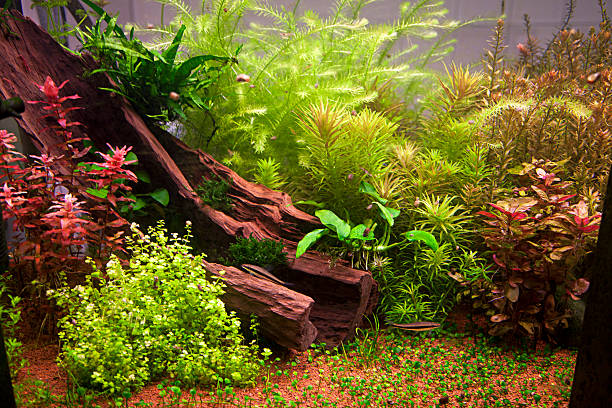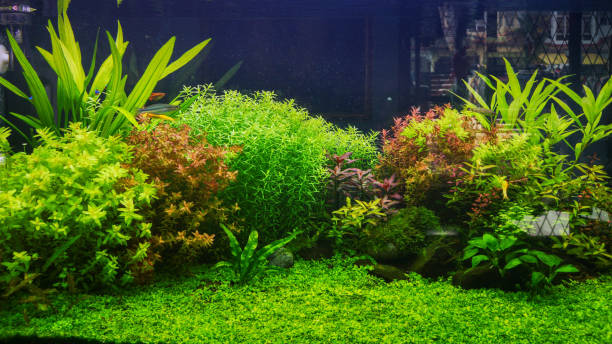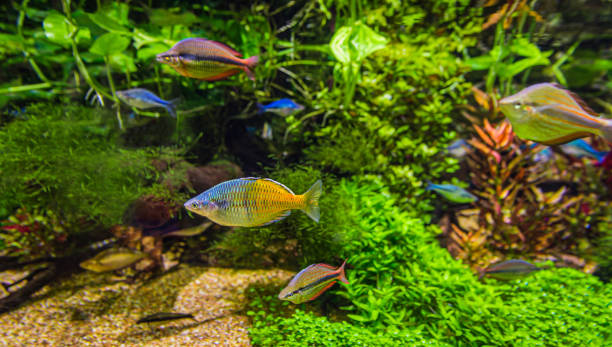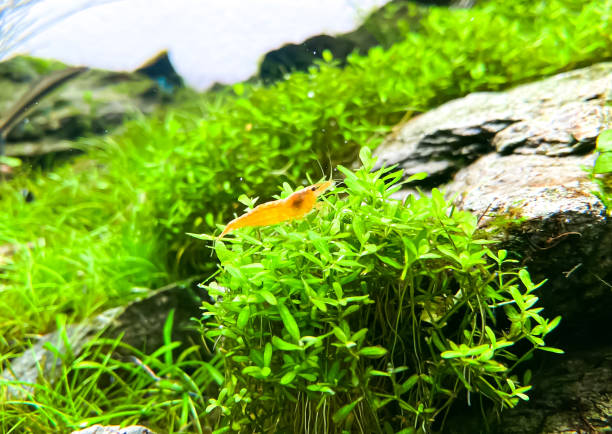Aquariums are not only delightful to behold but also provide a soothing and immersive experience. They offer a slice of nature within the confines of our homes, bringing tranquility and beauty to any space. One crucial element for a thriving aquarium ecosystem is aquatic plants. These green wonders not only enhance the visual appeal but also contribute to the overall health and balance of the aquatic environment. In this comprehensive guide, we will explore the best plants for beginner aquariums, shedding light on their unique qualities, care requirements, and the benefits they bring to your aquatic oasis.
The Benefits of Aquatic Plants

Before delving into the best plant choices, it’s important to understand the numerous benefits they provide to your aquarium. Aquatic plants play a vital role in your aquarium ecosystem in maintaining water quality, providing oxygen, creating natural hiding places, and contributing to the overall health and balance of the aquatic environment. One of
the significant benefits of aquatic plants is their ability to absorb excess nutrients, thereby helping to maintain water quality.
They uptake nutrients like nitrates and phosphates, which are byproducts of fish waste and decaying matter. By reducing the nutrient levels, they prevent the overgrowth of algae, promoting a clearer and healthier aquatic environment. Aquatic plants also play a crucial role in oxygenating the water. Through the process of photosynthesis, they release oxygen into the water, which is vital for the well-being of fish and other inhabitants. Oxygen-rich water supports healthier respiration and metabolism, leading to happier and more active aquatic life. Furthermore, aquatic plants create natural hiding places for fish and invertebrates.
They offer shelter and protection, reducing stress and providing a sense of security for your aquatic friends. Hiding places are particularly important for shy or territorial species, helping them feel more at ease in their environment. In addition to their functional benefits, aquatic plants enhance the visual appeal of your aquarium. They bring a touch of natural beauty and create a more vibrant and realistic underwater landscape. The diverse colors, textures, and shapes of aquatic plants can transform your aquarium into a captivating living masterpiece. Moreover, aquatic plants contribute to the overall ecological balance of your aquarium.
They help establish a natural ecosystem by providing food sources, spawning areas, and habitats for beneficial microorganisms. This promotes a healthier and more sustainable environment for all inhabitants.
Choosing the Right Plants for Your Aquarium

To help readers make informed decisions, we offer guidance on selecting the right plants based on their aquarium setup. Aquatic plants can be categorized into foreground, midground, and background plants based on their growth patterns. Foreground plants are small and create a carpet-like effect in the front of the aquarium. Examples include Dwarf Hairgrass, Java Moss, and Staurogyne repens. Midground plants fill the middle section of the tank, adding depth and visual interest. Cryptocoryne species, Anubias nana, and Java Fern are popular choices for the midground.
Background plants are taller and serve as a backdrop, creating depth in the aquarium. Amazon Sword, Vallisneria, and Ludwigia are common background plants. Consider the compatibility of plants with your specific aquarium setup. Low-light plants, such as Anubias, Java Fern, and Cryptocoryne, are suitable for aquariums with limited or low-intensity lighting. They are beginner-friendly and less demanding in terms of lighting requirements. Moderate to high-light plants, including Amazon Sword, Hygrophila, and Rotala, require more intense lighting. Additionally, consider the water parameters preferred by different plant species. Some plants, like Vallisneria, prefer hard water, while Cryptocoryne can tolerate soft water.
Researching the preferred water conditions will contribute to the long-term health of your plants. Visual appeal is an important aspect of plant selection. Consider the colors, textures, and leaf shapes of the plants to create a harmonious aquascape. Plants like Ludwigia and Alternanthera offer vibrant red or purple hues, adding striking contrast to the greenery. Mosses, such as Christmas Moss or Flame Moss, can create intricate structures, while Vallisneria and Echinodorus species provide flowing leaves that add elegance and movement. For beginners, it is advisable to start with hardy and easy-to-maintain plants. Java Fern, Anubias, Cryptocoryne, and Hornwort are popular beginner-friendly choices.
These plants can tolerate a wide range of conditions, including low light and less frequent fertilization. As you gain experience, you can gradually experiment with more demanding plant species and advanced aquascaping techniques. Remember to research each plant’s specific care requirements and seek advice from experienced aquarists. Choosing the right plants for your planted aquarium is a crucial step towards creating a visually appealing and thriving aquatic environment. By considering growth patterns, compatibility, and visual appeal, you can create an aquascape that brings joy and tranquility to your home. With careful selection and proper care, your planted aquarium will flourish, providing a stunning natural masterpiece for all to admire.
Lighting and Photosynthesis

Lighting plays a crucial role in the growth and health of aquarium plants through the process of photosynthesis. Understanding the relationship between lighting and photosynthesis is essential for providing optimal conditions for your aquatic plants. This summary provides a detailed overview of how lighting influences photosynthesis in aquarium plants. Photosynthesis is the process by which plants convert light energy into chemical energy, utilizing carbon dioxide and water to produce oxygen and glucose. Light is the primary source of energy for photosynthesis, and the quality and intensity of light directly affect plant growth. When it comes to aquarium plants, the two key aspects of
lighting are the light spectrum and intensity.
The light spectrum refers to the different colors of light, typically measured in Kelvin (K) rating. Different parts of the light spectrum have varying effects on plant growth. Blue light (around 450-470nm) promotes compact growth and leaf development, while red light (around 650-680nm) stimulates flowering and overall plant growth. Light intensity refers to the amount of light reaching the plants, usually measured in lumens or lux. Each plant species has specific light intensity requirements. Insufficient light can result in weak growth or even plant decline, while excessive light can cause algae overgrowth and stress the plants. It’s crucial to find the right balance by considering the specific needs of your plants and adjusting the lighting accordingly. Aquarium lighting can be provided through different sources, such as fluorescent tubes, compact fluorescent bulbs, LED lights, or metal halide lamps.
LED lights have gained popularity due to their energy efficiency, longevity, and customizable lighting options, allowing aquarists to fine-tune the light spectrum and intensity. In addition to the light spectrum and intensity, the duration of light exposure also plays a role in plant growth. Most aquarium plants benefit from 8-12 hours of light exposure per day, simulating a natural day-night cycle. It’s important to establish a consistent lighting schedule to provide plants with the necessary light for photosynthesis. Regular maintenance of the lighting system is crucial to ensure optimal performance. Dust and algae can accumulate on light fixtures and reduce the amount of light reaching the plants. Cleaning the light fixtures periodically helps maintain the desired light intensity and quality.
For beginners seeking ease and simplicity, low-light plants are an excellent choice. Low-light plants offer a simple and low-maintenance option for aquarium enthusiasts. These plants are ideal for aquariums with limited or low-intensity lighting and are perfect for beginners or those seeking a hassle-free aquatic setup. Low-light plants provide several benefits, including easy care, compatibility with various water conditions, and the ability to thrive in lower lighting conditions. One of the key advantages of low-light plants is their easy care requirements. They are generally hardy
and can tolerate fluctuations in lighting, temperature, and water parameters. This makes them a suitable choice for beginners or individuals who prefer a low-maintenance aquarium. Low-light plants typically have slower growth rates, reducing the need for frequent pruning or trimming. Another benefit of low-light plants is their compatibility with a wide range of water conditions.
They can adapt to different water hardness levels, pH ranges, and temperature variations. This versatility allows aquarists to incorporate these plants into various aquarium setups, making them a popular choice for community tanks or setups with different fish species. Additionally, low-light plants can thrive in lower lighting conditions, such as aquariums without additional artificial lighting or with low-intensity lighting setups. They can utilize available light efficiently, making them suitable for aquariums placed in rooms with low natural light or tanks with limited access to direct sunlight. Low-light plants come in a variety of species, offering a range of choices for aquarists. Popular low-light plant options include Anubias, Java Fern, Cryptocoryne, and Mosses. These plants bring beauty and natural aesthetics to the aquarium, with their lush green foliage and unique leaf shapes.
Water Quality and Filtration

Water quality refers to the physical, chemical, and biological parameters of the water in an aquarium. It includes factors such as pH, temperature, ammonia, nitrite, nitrate levels, dissolved oxygen, and water hardness. Maintaining optimal water quality is essential for the overall health and growth of aquatic plants. Aquatic plants have specific water quality requirements for optimal growth. They rely on nutrients present in the water, such as nitrogen and phosphorus, for their nutrition.
Adequate levels of these nutrients, along with carbon dioxide (CO2), are necessary for photosynthesis, the process by which plants convert light energy into chemical energy. Monitoring and adjusting nutrient levels, as well as maintaining a proper balance between carbon dioxide and oxygen, are vital for promoting healthy plant growth. Filtration systems play a crucial role in maintaining water quality in aquariums. They remove physical debris, excess nutrients, and harmful substances from the water, helping to maintain a stable and clean environment for aquatic plants.
Mechanical filtration removes large particles, while biological filtration breaks down harmful substances, such as ammonia and nitrite, through beneficial bacteria. Certain filtration systems, such as planted aquarium filters or canister filters with bio-media, provide additional benefits for aquatic plants. These filters create a favorable environment for beneficial bacteria to colonize, enhancing biological filtration and promoting nutrient cycling. The plants can then absorb the converted nutrients, contributing to their growth and overall health.
Regular water testing is important to monitor water quality parameters and ensure they remain within acceptable ranges for both fish and plants. Testing kits are available to measure parameters such as pH, ammonia, nitrite, nitrate, and carbonate hardness. Maintaining appropriate water quality through regular water changes, nutrient supplementation, and filtration system maintenance is essential for the well-being of aquatic plants.
Coexistence with Fish and Invertebrates

In a planted aquarium, the coexistence of plants, fish, and other inhabitants creates a harmonious ecosystem. Compatibility between plants and fish is an important consideration when designing an aquarium. Some fish species may nibble on or uproot plants, while others coexist peacefully. Researching the behavior and diet of potential fish inhabitants helps in selecting plant-friendly species. Additionally, certain plants, such as floating plants or those with strong root systems, can provide shelter, spawning sites, or grazing areas for fish. Beneficial interactions between plants and fish enhance the overall health of the aquarium.
Fish produce waste that serves as a nutrient source for plants through the nitrogen cycle. In turn, plants absorb harmful substances and provide oxygen for the fish, contributing to a balanced ecosystem. Some fish, like algae-eating species, help control algae growth, maintaining water clarity and plant health. Creating an ideal habitat for both plants and aquatic life involves several considerations. Providing adequate hiding places and suitable tank mates for fish ensures their well-being and reduces stress. Maintaining water quality parameters within appropriate ranges, such as temperature, pH, and hardness, supports the health of both plants and fish.
Adequate filtration and regular water changes help keep the environment clean and minimize the accumulation of toxins. It is important to strike a balance between fish and plant populations to avoid overcrowding or excessive plant consumption. Planning the aquascape with the growth patterns of plants in mind ensures that they have enough space to flourish. Regular observation of the aquarium allows for early detection of any imbalances or issues and facilitates timely adjustments. By considering compatibility, encouraging beneficial interactions, and creating a suitable habitat, the coexistence of plants, fish, and other inhabitants in a planted aquarium can thrive.
This fosters a visually appealing and ecologically balanced environment, providing enjoyment for aquarium enthusiasts and promoting the well-being of all aquatic life.
Essential Care Tips
To ensure the long-term health and vitality of your aquatic plants, it is important to follow essential care tips:
Provide Adequate Lighting: Ensure that your aquarium plants receive the appropriate amount and quality of light. Research the light requirements of each plant species and invest in suitable lighting equipment. Maintain Proper Water Parameters: Monitor and maintain optimal water parameters such as pH, temperature, and water hardness. Regularly test water quality and make necessary adjustments to create a favorable environment for plant growth.
Nutrient Supplementation: Consider supplementing essential nutrients like nitrogen, phosphorus, and potassium through liquid fertilizers or substrate additives. This ensures that plants have access to the nutrients they need for healthy growth. Carbon Dioxide (CO2) Balance: Maintain a proper balance of carbon dioxide in the aquarium. This can be achieved through natural methods like CO2 injection systems or by utilizing liquid carbon supplements.
Adequate Water Circulation and Filtration: Promote good water circulation and invest in a reliable filtration system. This helps remove debris, excess nutrients, and promotes oxygenation, ensuring a clean and healthy environment for your plants.
Regular Pruning and Maintenance: Trim and remove any dead or decaying plant material to prevent the buildup of organic waste. This promotes healthy growth and prevents the onset of algae.
Monitor Algae Growth: Keep an eye on algae growth and take necessary measures to control it. Maintaining a healthy balance of nutrients, proper lighting, and regular maintenance will help prevent excessive algae growth.
Avoid Overstocking: Do not overcrowd the aquarium with too many fish or plants. Overstocking can lead to nutrient imbalances and hinder the growth of your aquatic plants.
Plan the Aquascape: Before adding plants, plan the layout and consider the growth patterns and compatibility of different species. This helps create a visually appealing and balanced aquascape.
Regular Observation and Adjustments: Continuously observe the plants for signs of nutrient deficiencies, algae growth, or any other issues. Make necessary adjustments to lighting, fertilization, or maintenance routines to ensure the long-term health and vitality of your aquatic plants.
By following these essential care tips, you can create an optimal environment for your aquatic plants, promoting their long-term health, and enjoying a thriving and visually stunning aquarium.
In conclusion, aquatic plants play a vital role in creating a healthy and visually appealing aquarium ecosystem. They contribute to water quality, provide oxygen, create hiding places, and enhance the overall balance of the environment. By choosing the right plants based on growth patterns, compatibility,visual appeal, and providing proper lighting, water quality and care, you can create a thriving aquatic oasis.
Maintaining optimal water parameters, nutrient supplementation, regular pruning, and monitoring for algae growth are essential for the long-term health of the plants. With attention to these factors, you can enjoy a beautiful and sustainable planted aquarium for years to come. I hope you have learned a few tips, please share with us your
experience if you already have a planted aquarium in the comment section. Happy Fish Keeping!
